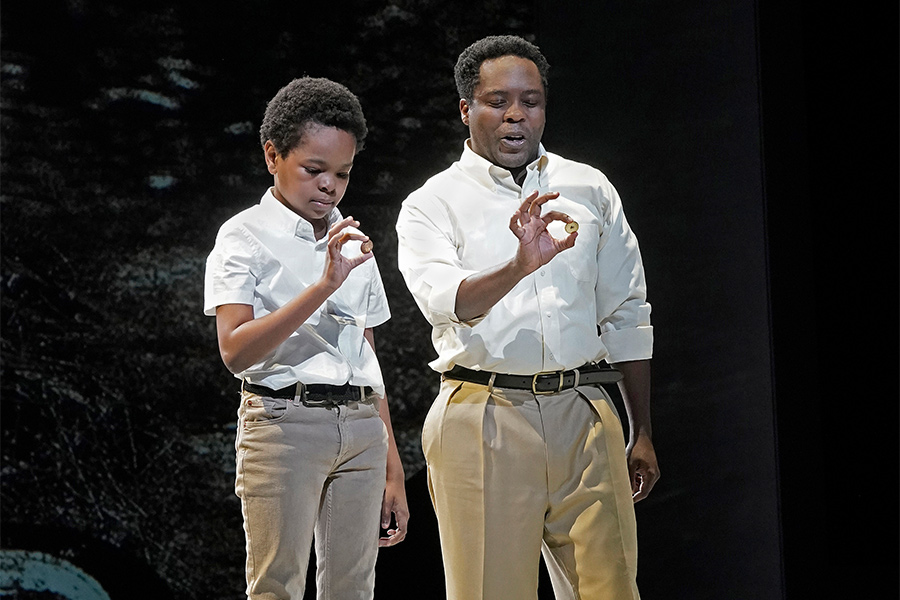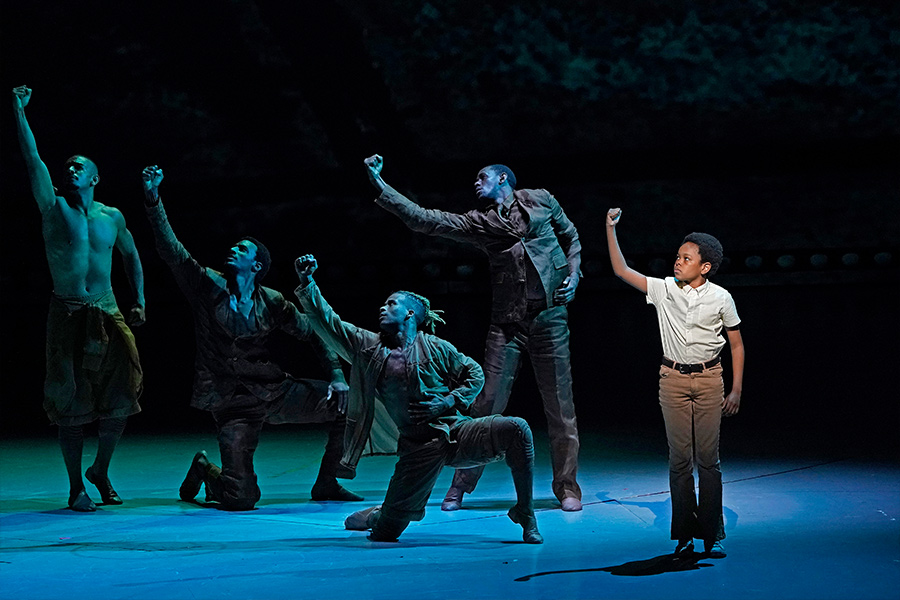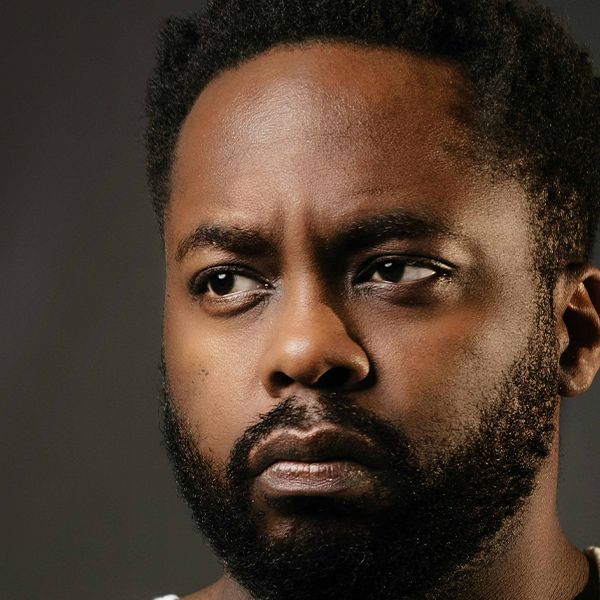March 16, 2022
Blaze of glory
Lyric Opera’s presentation of Terence Blanchard’s Fire Shut Up in My Bones — an expanded version co-commissioned with the Metropolitan Opera and LA Opera — takes its place in the rich history of vernacular popular, religious, and classical art music traditions in Chicago. Based on The New York Times columnist Charles M. Blow’s 2014 memoir of the same title, this is the second opera by a Black compositional team that has appeared at Lyric. The first took place in 1997, with the premiere of Anthony Davis’s Lyric commission Amistad (with libretto by Thulani Davis), an opera based on historical events about the African diaspora and the middle passage slave trade across the Atlantic. As with Amistad, Fire brings several major Black artists to Lyric in their debuts: leading singers Latonia Moore, Brittany Renee, Chauncey Packer, and co-director/ choreographer Camille A. Brown. This production also celebrates two Patrick G. and Shirley W. Ryan Opera Center alums: Will Liverman (in the central role) and Chris Kenney (Chester).
Fire Shut Up in My Bones is part of a much longer trajectory of operatic contributions by Black composers, librettists, singers, and collaborating artists. From the 19th century’s Elizabeth Taylor Greenfield and Sissieretta Jones (two of the best-known Black opera singers of their time) and the composers Henry Lawrence Freeman, Scott Joplin, William Grant Still, and many others, Black artists had been creating and singing opera long before Marian Anderson’s historic debut as Ulrica in Verdi’s Un ballo in maschera at the Metropolitan Opera on January 7, 1955. That performance became a symbolic desegregation of opera, as houses in the U.S. and Europe thereafter began to let Black singers onto their stages. Just five years after its founding, Lyric welcomed Leontyne Price on its stage in 1959 as Liù in Puccini’s Turandot and in the title role in Massenet’s Thaïs.
Over the past several decades, works of Black opera composers — notably Davis’s X, The Life and Times of Malcolm X (1986) — have ushered in a new generation to which Blanchard belongs. In addition to Amistad at Lyric in 1997, Davis’s many operas include the Pulitzer Prize-winning The Central Park Five (2019). Recent years have brought the premieres of many more important operas by Black composers, including Nkeiru Okoye’s Harriet Tubman: When I Crossed that Line to Freedom (2014), George Lewis’s Afterword (2015), about the founding of Chicago’s Association for the Advancement of Creative Musicians, and Daniel Bernard Roumain’s We Shall Not Be Moved (2017).
While Blanchard is no stranger to opera, he is better known as a celebrated jazz trumpeter and film score composer, winning Grammy Awards for his jazz recordings and collaborating frequently with film director Spike Lee — as a trumpet player in Lee’s early movies and as the film score composer for many others. (He was nominated for an Academy Award last year for his score to Lee’s Da 5 Bloods.) He has worked with other film directors over the years and created the music for two recent films that have trenchantly documented important Black historical figures and experiences: One Night in Miami... (2020) and Harriet (2019), the latter a collaboration with Lemmons, who directed the award-winning movie. “With Harriet, there was no other composer I could imagine,” Lemmons says. “I wanted a big American sound and a lush, full, heroic score.” But their partnership goes back even further, beginning with Lemmons’s first film, Eve’s Bayou (1997) and continuing with several of her other movies. Bringing her experience as an actress, screenwriter, film director, and opera lover to her work on Fire, Lemmons’s libretto — her first — breathes a penetrating drama into this nuanced story. Here, as in all her films, Lemmons shows her mastery at weaving together sophisticated community scenes and intimate hidden stories.

Will Liverman as Charles (right) shares a moment with his younger self, Char’es-Baby, in the Metropolitan Opera’s production.
Fire is Blanchard’s second opera and the second commissioned from him by Opera Theatre of Saint Louis, where James Robinson is Artistic Director (also making his debut at Lyric, as co-director). Blanchard’s first, Champion (2013), which he calls an “opera in jazz,” was about the boxer Emile Griffith (1938-2013), who was haunted both by his bisexuality and his brutal knockout of Benny Paret in 1962, which put Paret in a coma and led to his death ten days later. “Champion was such a success that on opening night we immediately asked Terence to write another opera for us,” Robinson says. “It took a while to land on a subject that really inspired Terence, but then one day his wife and I both read an article in The New York Times by Charles Blow that previewed his forthcoming memoir. We thought Charles’s story would make a wonderful opera, and Terence immediately responded to the idea.”
When Blow met with Blanchard to discuss the idea of an opera, Blow remembers, “Terence and I just talked. I knew his work. We’re both from Louisiana and the whole thing. My thought was, as long as it ends properly, go for it.” The opera condenses the book and embraces the texture and rhythms of young Charles’s life growing up in the small town of Gibsland, Louisiana — the love of his mother and siblings, the secret of his sexual abuse at the hands of two extended family members, and his path through recognizing the trauma and finding a way forward.
A theme that links Blanchard’s two operas is their portrayal of Black men in the public eye whose bisexuality leads to bullying, shame, trauma, and inner turmoil. Both operas involve the past and the present coming together as their protagonists age, and use different singers to represent the boy and the mature man.
“The role of Charles is so intense, so raw. It just grabs you immediately,” says Liverman, who headlines the production. “It’s the journey of finding a way to stand, two feet planted on the ground, and say, ‘This is who I am.’ A way of living with that truth and not being afraid to display it.”
It's the journey of finding a way to stand, two feet planted on the ground, and say, 'This is who I am.' A way of living with that truth and not being afraid to display it.
In working out how best to portray Charles’s complicated inner life in her libretto, Lemmons took inspiration from a conversation with Robinson, who she says opened her mind to the freedom and possibilities available in opera. “One of the things he said that really sank in was that, in opera, anything can sing,” she remembers. “I really embraced that. So first I thought that the trees could sing, and then I took that a step further and thought, well, maybe his loneliness can sing.” In the end, one of the two principal female roles (sung by soprano Brittany Renee) encompasses three characters: Greta, a love interest of Charles’s, and the forces of Destiny and Loneliness. The other primary female role is Charles’s mother, Billie, portrayed by soprano Latonia Moore.
Another important part of Charles’s journey takes place during his time at Grambling State, a historically Black university, where he joins a Black fraternity known for its step shows. Given the college scenes in Act III, co-director and choreographer Brown knew that she wanted to include a step dance — bringing that tradition into a context where, even during the lifetimes of some members in todays’ audiences, Black people were not even allowed on the stage. “I thought it was especially important,” she says. “We are talking about a step that comes from the rich history of the African diaspora.”

Char’es-Baby and the company of dancers in the Metropolitan Opera’s production.
When Blanchard was growing up in New Orleans, his father — a singer who loved classical music — wanted his son to be involved with opera. “He was an amateur baritone, and he really wanted to be an opera singer,” Blanchard says. “When he was a younger kid in the 1930s and 1940s, you know, he wasn’t given opportunities to do that.” When James Robinson asked Blanchard to write his first opera, Blanchard was moved to tears. “Right then, I could see my dad up in heaven going, ‘I told you. I told you!’” he says. “I kept thinking about how this is really the life he wanted.”
Fire Shut Up in My Bones is an opera that encompasses multitudes. Blanchard’s style of bringing jazz, gospel, and blues together creates a dynamic but lyrical operatic world that both propels the drama and allows it to bloom. The story has painful and tender moments, spanning the last third of the 20th century and into the present day, a period during which the United States has witnessed rapid yet uneven changes in attitudes about manhood, sexuality, and their intersections with race. Brown sums up the nature and importance of the story by describing it as “a Black experience. And people need to see as many Black experiences as possible.”
Yet power and violence around sexual encounters are, tragically, everyone’s experiences in some way, whether through bullying, harassment, and assault directly, or as a bystander, friend, or loved one witnessing the damage and struggle for healing. “It’s a very human, very relatable piece,” Robinson says. “There’s a lot of societal pressure that Charles deals with, and even if someone hasn’t been the victim of abuse, they can understand what it’s like to be different, to be an outsider, and all the trials that go along with that.”
I think that there’s a space for everybody to walk away feeling some kind of universal theme, within this very specific story.
Blanchard also sees a larger message within the particular contours of Blow’s memoir. “Anybody who comes to see this will understand what Charles persevered through, and we know he’s still working and he’s still productive,” he says. “The story’s not finished — this is just one chapter.” The powerful new stories of contemporary Black operas bring together individual private experiences that communicate the shared humanity in all of us and provide a charge for the future of the art form. Seeing a work like Fire on the great opera stages of the world “is something that can help propel some other little kids forward into wanting to become composers,” Blanchard says. “And that’s my hope. That’s my dream.”
Naomi André is a professor at the University of Michigan and the author of Black Opera: History, Power, Engagement.
Adapted from an article commissioned and published by the Metropolitan Opera, 2021.
March 24 – April 8, 2022
Fire Shut Up in My Bones
Fire Shut Up in My Bones
New York Times columnist Charles M. Blow’s widely acclaimed memoir is the source for this extremely moving story of his traumatic youth in Louisiana. What an amazing collection of talent — composer Terence Blanchard, one of the most influential figures in American jazz; librettist Kasi Lemmons, director of such remarkable films as Harriet and Eve’s Bayou; and a topflight cast including many of America’s most brilliant singing actors. Fire Shut Up in My Bones is an opera for today, revealing the Black experience in this country as few other operas have done.

